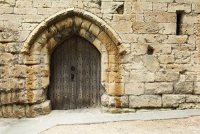Man-made masonry arches are architectural marvels that have been utilized for centuries to create structurally sound and enduring constructions. These arches demonstrate the exceptional strength and endurance of masonry as a building material. Let's delve into the characteristics, construction techniques, and the remarkable durability of man-made masonry arches.
Masonry arches are typically constructed using stones or bricks arranged in a curved shape that transfers the load from above to the supporting piers or abutments on either side. The curvature of the arch allows it to distribute the weight evenly along its span, resulting in remarkable load-bearing capacity. This unique design feature enables masonry arches to span considerable distances and support heavy loads, making them ideal for constructing bridges, aqueducts, cathedrals, and other monumental structures.
One of the key factors contributing to the strength and endurance of masonry arches is the use of strong and durable materials. Stones such as granite, limestone, or sandstone, and bricks made from fired clay or concrete, are commonly employed. These materials possess excellent compressive strength, allowing them to withstand the immense forces exerted on the arch. The carefully selected and well-laid masonry units create a robust and stable structure that can withstand the test of time.
The construction of masonry arches involves precise craftsmanship and meticulous planning. The shape and dimensions of the arch are carefully calculated, taking into account factors such as the span, rise, and angle of the arch. The stones or bricks are cut and shaped to fit the curvature of the arch, ensuring a tight fit and uniform distribution of loads. Mortar, a binding material made from a mixture of sand, cement, and water, is used to bond the masonry units together, providing additional strength and stability to the structure.
The inherent strength of masonry arches is further enhanced by the concept of "voussoirs" and the keystone. Voussoirs are the wedge-shaped stones or bricks that make up the arch, arranged in a radial pattern. The keystone, the central and highest voussoir, is vital in providing stability and load transfer. The downward pressure on the keystone locks the voussoirs into place, creating a self-supporting arch structure that can withstand significant loads.
The enduring nature of man-made masonry arches can be observed in numerous ancient and historic structures that have stood for centuries. Examples include the Pont du Gard in France, the aqueduct that has been serving as a testament to Roman engineering since the 1st century AD, and the Pantheon in Rome, a remarkable architectural achievement that has defied the passage of time. These structures showcase the exceptional durability and longevity of well-constructed masonry arches.
Moreover, masonry arches are known for their resistance to external forces, such as earthquakes and fire. The inherent strength and mass of the masonry materials provide a level of resilience against seismic activity, making masonry arches a preferred choice for areas prone to earthquakes. Additionally, the non-combustible nature of stones and bricks ensures that masonry arches can withstand high temperatures, enhancing their fire resistance compared to other building materials.
In conclusion, man-made masonry arches are renowned for their exceptional strength and endurance. The careful construction techniques, the selection of robust materials, and the architectural principles employed in their design contribute to their remarkable load-bearing capacity and long-lasting nature. From ancient wonders to historic landmarks, these arches stand as a testament to the skill and ingenuity of architects and craftsmen, showcasing the enduring legacy of masonry as a building technique.
